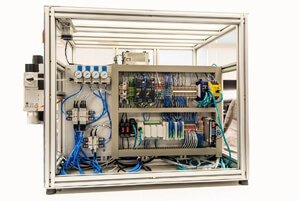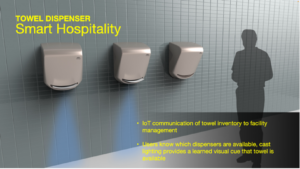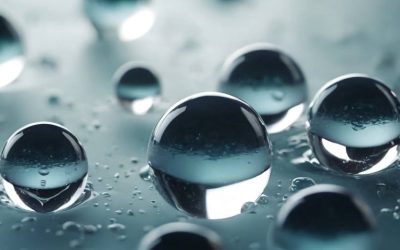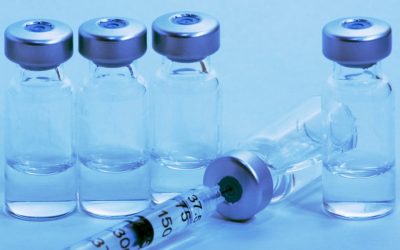THE PROJECT
Develop a production in-line calibration station for a suture fastening system used in open surgical and laparoscopic procedures. The machine must be designed to meet a capacity of 1000 units per day and capable of being used in a Class 8 cleanroom environment. Our client required an automated solution to support data accuracy, consistency, and support of our client’s Industry 4.0 initiatives.
THE CLIENT
The client is a global leader in patient-focused medical innovations for structural heart disease, cardiac critical care, and surgical monitoring. They provide life-saving tissue replacement and transcatheter heart valves and repair products.
THE CHALLENGE
The client’s device is designed to replace the standard process of manually tying sutures in open and laparoscopic surgeries. This device is designed to draw the suture into the distal end of its outer tube and deploy a fastener to eliminate the need for manual suture knots.
Because of the extremely tight tolerances required in this device design, calibration is required to ensure proper device functioning and indexing during device deployment. Force-4/SES’s engineers were tasked with developing an automated calibration station to be used during the device assembly process before final inspection and device shipment to the end user.


Figure 2: Force-4, “Smart Hospitality”, Towel Dispenser
THE SOLUTION
The calibration station was designed to interact with the device’s setup mode to initialize the fastener position prior to final inspection. The equipment operated in a defined process to establish and synchronize specific components with the setpoint variables contained within the device’s operating system.
A precision position sensor to measure of the inner tube position relative to the end of the outer tube’s end. An accelerometer was used to confirm the inner tube’s interaction with the distal fastener. The calibration machine then positioned the distal fastener to the end of the device using closed-loop feedback from a contact sensor.
DEVELOPMENT
Force-4/SES’s engineers developed a method whereby an accelerometer was used to detect the dynamic interaction of two device components when used. The accelerometer output is processed in real-time and used to confirm the position of assembled components for calibration. This was also used to train the software set point. [Two medium-sized products were used to confirm calibration position with a peak acceleration.] Thereby enabling the engineers to determine the appropriate location required for calibration and train the device software setpoints. Final confirmation of the calibration method was repeated for all device sizes and lengths.
THE DESIGN PROCESS
The Force 4/SES Automation Development Team follow our 3DS development process to deliver consistent and cost-effective machine design to our clients. The high-level deliverables associate with this project include:
- Proposal based on client User requirements and project delivery metrics (Cost and Timing).
- Strategize how to effectively measure the device’s critical positions
- Demonstrate bench testing for defined measurement detection method
- Conceptualized machine process and system components
- Update engineering requirements document based on learnings
- Conduct process design and engineering for discrete modeling
- Evaluate for process control and test stability
- Provide subscale testing as needed in support of design efforts
- Develop of bill of materials (BOM)
- Fabrication
- Assembly of the mechanical and electrical subsystems
- Execute factory acceptance testing (FAT)
- Provide necessary documentation to client
SUCCESS!
Force-4/SES’s Automation Team conducted successful factory acceptance testing and confirmed all design performance criteria was met. Our team completed the automation design project within expected budget and time parameters.
At Force-4, we are a passionate, multidisciplinary team of expert problem-solvers ready to tackle your most challenging technical problems. We pride ourselves on our innovative solutions, which elevate the way businesses operate. We have been providing forward-thinking solutions for companies and industries that require in-depth technical knowledge and proven performance in engineering design and analysis, thermal and fluid sciences, instrumentation, and testing.
More about Force-4 & SES Team:
Force-4 and its engineering services parent company, Stress Engineering Services, Inc.(SES), have 50 years of experience developing and deploying proprietary predictive analysis methods that accelerate the development process while reducing development risk. Our human-centered and design-by-analysis approach eliminates trial and error rework and enables design optimization before it is necessary to commit to tooling.
AUTHORS

- Clint Haynes, founder of the Cincinnati office of Stress Engineering Services, has steadily grown the Cincinnati practice area while introducing breakthrough capabilities. He has a specialized focus on areas of medical, outdoor, and product innovation.
- Mike Johnson, Principal, has more than 30 years of innovation in product development, design control, new product transfers, and short-run manufacturing.
Ref: C002-MD-Calibration Station Developed For Fastening System Used In Medical Device Manufacturing
Keep in touch with us.
Sign up for our newsletter.



